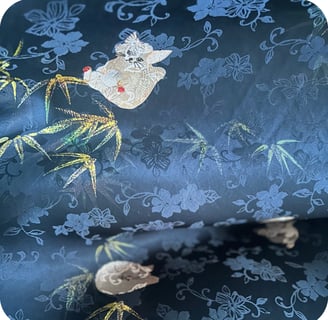The Development and Future of Jacquard Fabrics
Jacquard fabric, known for its intricate patterns and high quality, has become a significant player in both fashion and home décor industries. As textile technology advances and market demands evolve, the development of jacquard fabrics is entering a new phase. The future of jacquard fabrics will be shaped by innovations in smart textiles, sustainable materials, and digital design, opening up new possibilities for its application.
CC Textile-FTY WhatsApp:+86 153 0626 7080
10/8/20241 min read


Historical Background of Jacquard Fabrics
Jacquard fabrics originated in the 19th century with the invention of the Jacquard loom by Joseph Marie Jacquard, a French inventor. The introduction of the Jacquard loom marked a significant technological leap in the textile industry, allowing intricate patterns to be woven automatically. This innovation revolutionized traditional hand-weaving methods, greatly improving production efficiency and opening new design possibilities for fashion, home décor, and textile arts.
Contemporary Development of Jacquard Fabrics
Today, the production of jacquard fabrics has reached a new level. Modern Jacquard looms, with their high-speed operations and precision control, make the production process more efficient and reliable. The use of advanced fiber materials, such as polyester, nylon, and various blends, enhances the durability and versatility of jacquard fabrics. They are widely used in high-end fashion, home textiles, curtains, upholstery, and technical textiles.
Future Trends: Smart Textiles and Sustainable Materials
In the future, the rise of smart textiles will open new application areas for jacquard fabrics. By integrating sensor technology and nanofiber materials, jacquard fabrics could become part of smart clothing, medical textiles, and sports equipment. The development of eco-friendly materials will also be a key trend. The use of biodegradable fibers, recycled materials, and environmentally friendly dyeing processes can reduce the environmental impact of production while meeting consumer demands for sustainable fashion.
Digital Design and Customization
As digital technology advances, the design and production of jacquard fabrics are also transforming. Digital weaving systems allow designers to create intricate patterns directly through computers, significantly shortening the time from design to production. Furthermore, customization has become a key market demand, with consumers able to participate in the design process through digital platforms to create unique jacquard products. This trend will drive the further development of jacquard fabrics, particularly in high-end fashion and home décor.
Conclusion
After centuries of development, jacquard fabrics remain vibrant and relevant. In the future, with technological advancements and the growing awareness of sustainability, jacquard fabrics will continue to hold an important position in the textile industry. Through technological innovation and market demand, they will exhibit even broader application prospects.
Get in touch
Address
Suzhou CC Textile Co.,LTD
4101 West Ring 2nd Road, Shengze Town, Wujiang District, Suzhou, Jiangsu Province, China
ZIP Code:215228
